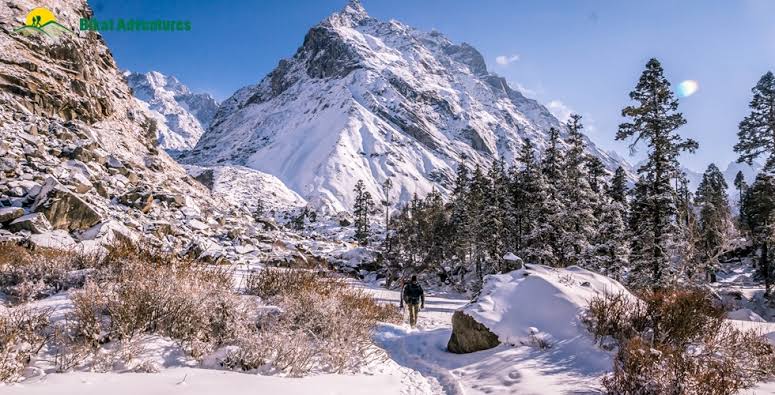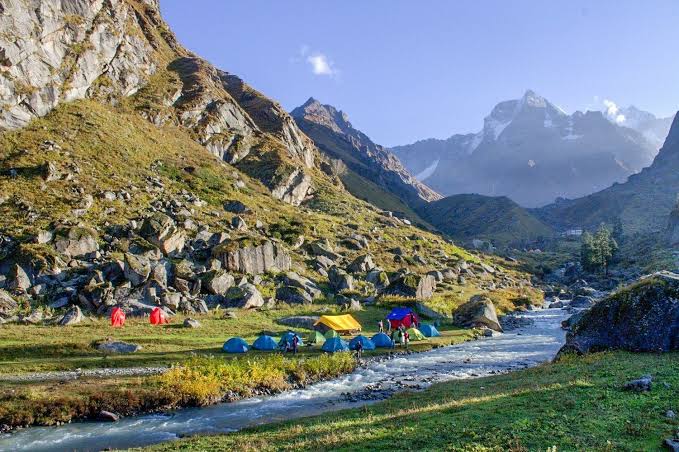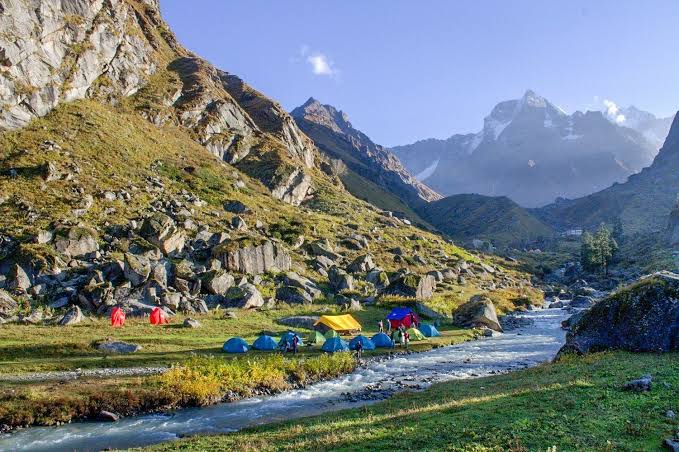Har Ki Dun, known as the 'Valley of Gods', is one of the most beautiful and ancient valleys in the Himalayas. Located at an altitude of 3,566 meters (11,700 feet) in the Garhwal region of Uttarakhand, this cradle-shaped valley offers spectacular views of pristine Himalayan landscapes, traditional villages, and a rich cultural heritage dating back to the Mahabharata era.
Overview
The Har Ki Dun trek takes you through one of the oldest inhabited places in the Himalayas, where villages maintain their ancient architectural style and cultural traditions. The valley is surrounded by snow-capped peaks like Swargarohini (meaning 'stairway to heaven'), Bandarpoonch, and Black Peak. According to legend, this is the path the Pandavas took on their journey to heaven. The trek offers diverse landscapes including dense pine forests, terraced fields, glacial valleys, and alpine meadows, making it a paradise for nature lovers and photographers.

Itinerary
Day 1: Drive from Dehradun to Sankri (6,400 ft) | 10-11 hours
The journey begins with a scenic drive from Dehradun to Sankri village, passing through Mussoorie, Purola, and Mori. Enjoy views of the Tons River valley and distant Himalayan peaks. Upon arrival at Sankri, check into a guesthouse and explore this gateway village to many Himalayan treks. Overnight stay in Sankri.
Day 2: Drive from Sankri to Taluka (6,900 ft) and trek to Seema (8,000 ft) | 12 km | 5-6 hours
After breakfast, take a short drive to Taluka village. Begin the trek along a gradual trail following the Supin River through dense pine and oak forests. Pass by small waterfalls and streams before reaching the campsite at Seema. Overnight in tents at Seema.
Day 3: Trek from Seema to Osla Village (8,500 ft) | 5 km | 3-4 hours
A relatively short day of trekking takes you to the ancient village of Osla. The trail crosses the Supin River and gradually ascends through forests and terraced fields. Explore Osla village with its unique wooden houses and traditional lifestyle. Overnight in tents or a homestay in Osla.
Day 4: Trek from Osla to Har Ki Dun (11,700 ft) | 11 km | 6-7 hours
The trail from Osla to Har Ki Dun offers spectacular views as you gain altitude. Pass through pine forests, meadows, and alongside the Supin River. Reach the magnificent Har Ki Dun valley by afternoon, with panoramic views of Swargarohini peaks. Set up camp and explore the surrounding area. Overnight in tents at Har Ki Dun.
Day 5: Explore Har Ki Dun Valley and hike to Maninda Tal (optional) | 4-5 hours
Spend the day exploring the beautiful Har Ki Dun valley. Optional hike to Maninda Tal, a small alpine lake, or explore the upper reaches of the valley for better views of the surrounding peaks. Return to the campsite by evening. Overnight in tents at Har Ki Dun.
Day 6: Trek from Har Ki Dun to Osla/Seema | 11-16 km | 6-7 hours
Begin the return journey, descending from Har Ki Dun to either Osla or Seema depending on the group's pace. The downhill trek offers different perspectives of the landscapes you passed on the way up. Overnight in tents at Osla or Seema.
Day 7: Trek from Osla/Seema to Taluka and drive to Sankri | 12-17 km | 6-7 hours
Complete the final leg of the trek from Osla/Seema to Taluka. After reaching Taluka, drive back to Sankri village. Celebrate the successful completion of the trek with fellow trekkers. Overnight stay in a guesthouse at Sankri.
Day 8: Drive from Sankri to Dehradun | 10-11 hours
After breakfast, begin the return journey to Dehradun. The drive takes approximately 10-11 hours, passing through the same scenic route. Arrive in Dehradun by evening, marking the end of the trek.

The Route
The trek begins from Sankri village (6,400 ft), accessible from Dehradun. From Sankri, the trail proceeds to Taluka (6,900 ft), then to Osla and Seema villages, showcasing traditional Himalayan architecture. The path continues through pine forests and alongside the Supin River to reach Har Ki Dun valley (11,700 ft). Throughout the journey, trekkers are treated to magnificent views of Swargarohini peaks and can explore ancient villages where time seems to have stood still. The return journey follows the same route back to Sankri.
Highlights Along the Way
- Spectacular views of Swargarohini peaks, Bandarpoonch, and Black Peak
- Ancient villages with unique architecture and rich cultural heritage
- Diverse landscapes including pine forests, meadows, and glacial valleys
- Opportunities to interact with locals and experience their traditional lifestyle
- Rich biodiversity with rare Himalayan flora and fauna
- Historical significance with connections to the Mahabharata epic
Best Time to Visit
The best time to visit Har Ki Dun is during the pre-monsoon months (April to June) and post-monsoon months (September to November). Spring brings blooming wildflowers and moderate temperatures, while autumn offers clear skies and excellent visibility of the mountain peaks. The valley is also accessible during winter (December to February), offering a magical snow-covered landscape, though temperatures can drop significantly. The trek is closed during the monsoon season (July to August) due to heavy rainfall and landslides.
Difficulty and Preparation
Har Ki Dun is a moderate trek suitable for beginners with good fitness levels. The maximum altitude of 11,700 feet means some acclimatization is necessary, but altitude sickness is generally not a major concern. Trekkers should be able to walk 5-7 kilometers daily with a light backpack. Regular cardiovascular exercise, strength training for legs, and practice hikes are recommended before attempting this trek. The trail involves gradual ascents and some steep sections but no technical climbing.

Accommodation
Accommodation during the Har Ki Dun trek includes a mix of guesthouses, forest rest houses, and camping. The first and last nights are typically spent in basic guesthouses in Sankri. During the trek, you'll stay in tents at designated campsites or in basic forest rest houses when available. In some villages like Osla, homestays offer a chance to experience local hospitality. Tents are provided on a sharing basis with sleeping bags and mats suitable for the weather conditions. The campsites offer stunning views of the surrounding mountains and valleys.
Local Culture
The Har Ki Dun valley is home to the Pahadi people who maintain centuries-old traditions and a unique way of life. The villages in this region feature distinctive wooden houses with intricate carvings and architecture that has remained unchanged for generations. The local communities follow ancient customs, celebrate traditional festivals, and practice sustainable agriculture on terraced fields. Their folklore includes many stories related to the Pandavas from the Mahabharata epic, who are believed to have passed through this valley on their way to heaven.
Conservation
Har Ki Dun is located within the Govind Wildlife Sanctuary and National Park, which is home to diverse flora and fauna including Himalayan black bears, leopards, musk deer, and numerous bird species. The region is also rich in medicinal plants and rare Himalayan herbs. Conservation efforts focus on preserving this biodiversity while promoting sustainable tourism. Trekkers are expected to follow responsible practices such as carrying back all non-biodegradable waste, using designated trails, and respecting local customs and natural resources.
Frequently Asked Questions
How difficult is the Har Ki Dun trek compared to other Himalayan treks?
Har Ki Dun is considered a moderate trek suitable for beginners with good fitness levels. It's less challenging than treks like Rupin Pass or Roopkund but more demanding than Kedarkantha or Dayara Bugyal due to its longer duration and higher altitude.
Is it possible to see snow during the Har Ki Dun trek?
Yes, snow can be seen during winter months (December to March) when the entire valley is covered in a thick blanket of snow. During April-May, you might still find some snow patches at higher elevations, while September-November typically has no snow.
Are there any age restrictions for this trek?
While there are no strict age restrictions, the trek is recommended for individuals between 12-60 years with good physical fitness. Children under 12 should have prior trekking experience, and those above 60 should consult their doctor before attempting the trek.
What makes Har Ki Dun culturally significant?
Har Ki Dun is believed to be the path taken by the Pandavas on their journey to heaven as mentioned in the Mahabharata. The villages in this region maintain centuries-old architecture, traditions, and customs that have remained largely unchanged, offering a glimpse into ancient Himalayan culture.
Is it possible to get network connectivity during the trek?
Network connectivity is extremely limited during the trek. You might get patchy BSNL signals at Sankri, but once you start trekking, expect to be completely disconnected. It's advisable to inform family and friends about your limited connectivity beforehand.
Trek Information
Location
Uttarakhand, India
Duration
7-8 days
Difficulty
Moderate
Best Season
March-June, September-November
Group Size
8-15 people
Max Altitude
11,700 ft (Har Ki Dun)
Start & End Point
Sankri Village
Inclusions & Exclusions
✅ Included:
- ✔Transportation from Dehradun to Sankri and back
- ✔All meals during the trek (vegetarian)
- ✔Accommodation (Guesthouse in Sankri, tents/forest rest houses during the trek)
- ✔Qualified and experienced trek leader and support staff
- ✔Camping equipment (tents, sleeping bags, mats)
- ✔Permits and entry fees
- ✔First aid medical kit
❌ Excluded:
- ✖Personal expenses and tips
- ✖Travel insurance
- ✖Any costs arising out of unforeseen circumstances like landslides, roadblocks, bad weather
- ✖Anything not mentioned in inclusions
What to Pack
- Sturdy waterproof trekking shoes with good ankle support
- Layered clothing (thermal inner wear, fleece jacket, windproof outer layer)
- Rain protection (poncho or waterproof jacket)
- Sun protection (hat, sunglasses, sunscreen)
- Trekking poles for stability
- Headlamp with extra batteries
- Personal medical kit with basic medications
- Water bottles and water purification tablets
- Warm gloves, socks, and cap
- Backpack with rain cover
Weather Conditions
Spring (March-June)
Daytime temperatures 10-20°C, night temperatures 0-5°C, occasional light showers
Autumn (September-November)
Daytime temperatures 8-15°C, night temperatures -2 to 5°C, clear skies and stable weather
Winter (December-February)
Daytime temperatures 0-8°C, night temperatures -10 to -5°C, heavy snowfall
Monsoon (July-August)
Trek closed due to heavy rainfall, landslides, and blocked trails
Food & Cuisine
During the trek, all meals are provided and typically include nutritious vegetarian food. Breakfast usually consists of porridge, upma, poha, or paratha with tea. Lunch is often packed and includes items like sandwiches, rolls, or parathas with pickle. Dinner at the campsite features rice, dal, vegetables, chapati, and sometimes a dessert. Hot beverages like tea and soup are regularly served to keep trekkers warm, especially in the evenings.
Local Specialties:
- Mandua ki Roti - Nutritious flatbread made from finger millet
- Jhangora ki Kheer - Sweet pudding made from barnyard millet
- Aloo ke Gutke - Spicy potato dish with local herbs
- Kafuli - Spinach and fenugreek leaves preparation
- Garhwali Dal - Local lentil preparation with unique spices
